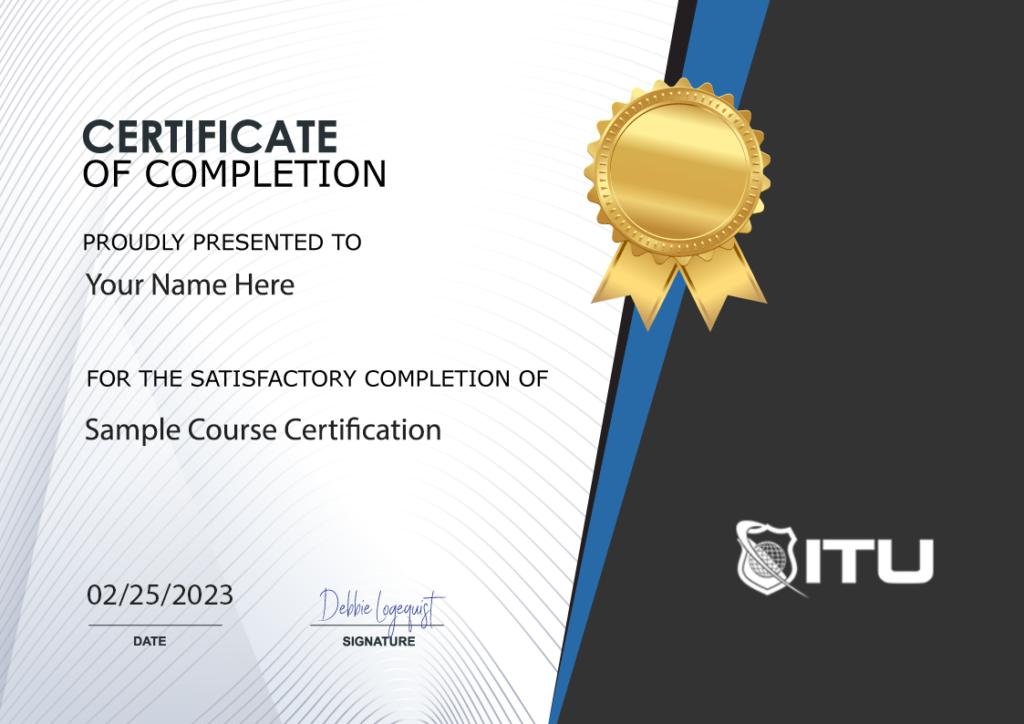Microsoft Server Technology Training Series
This limited-time offer includes 8 courses including our brand new MTA courses covering Microsoft Technology.
Included In This Course



Closed Captions



Certificate of Completion
Proudly DisplayYour Achievement
Upon completion of your training, you’ll receive a personalized certificate of completion to help validate to others your new skills.
Microsoft 98-365 MTA Windows Server 2016 Administration Course Content
Module 1 Introducing Windows Server 2016
- Module 1 Notes
- 1. Windows Server 2016 Fundamentals Intro
- 2. Mod 1 Introducing Windows Server 2016
- 3. Mod 1a Introducing Windows Server 2016
Module 2 Managing Windows Server 2016
- Module 2 Notes
- 4. Mod 2 Managing Windows Server 2016
- 5. Mod 2a Managing Windows Server 2016
Module 3 Managing Storage
- Module 3 Notes
- 6. Mod 3 Managing Storage
- 7. Mod 3a Managing Storage
Module 4 Monitoring and Troubleshooting Servers
- Module 4 Notes
- 8. Mod 4 Monitoring and Troubleshooting Servers
- 9. Mod 4a Monitoring and Troubleshooting Servers
Module 5 Essential Services
- Module 5 Notes
- 10. Mod 5 Essential Services
- 11. Mod 5a Essential Services
Module 6 Understanding File and Print Services
- Module 6 Notes
- 12. Mod 6 Understanding File and Print Services
Module 7 Windows Network Services and Applications
- Module 7 Notes
- 13. Mod 7 Windows Network Services and Applications-
- 14. Mod 7a Windows Network Services and Applications-
Mod 8 Key Takeaways
- Key Takeaway Notes
- 15. Key takeaways Intro
- 16. Key takeaways - Module 1 Introducing Windows Server 2016
- 17. Key takeaways - Module 2 Managing Windows Server 2016
- 18 Key takeaways - Module 3 Storing Data in Windows Server 2016
- 19. Key takeaways - Module 4 Monitoring and Troubleshooting Servers
- 20. Key takeaways - Module 5 Essential Services
- 21. Key takeaways - Module 6 Understanding File and Print Services
- 22. Key takeaways - Module 7 Windows Network Services and Applications
Mod 9 Terms to Know
- Terms to Know Notes
- 23. Terms to Know Intro
- 24. Terms to Know - Module 1 Introducing Windows Server 2016
- 25. Terms to Know - Module 2 Managing Windows Server 2016
- 26 Terms to Know - Module 3 Storing Data in Windows Server 2016
- 27. Terms to Know - Module 4 Monitoring and Troubleshooting Servers
- 28. Terms to Know - Module 5 Essential Services
- 29. Terms to Know - Module 6 Understanding File and Print Services
- 30. Terms to Know - Module 7 Windows Network Services and Applications
Mod 10 Hands on Labs
- Hands on Labs Setup Notes
- 01 MTA 98-365 Windows Server 2016 Administration Fundamentals Lab setup
- 02 Step by Step Install VMware Player 15 in Windows 10 1
- 03 Installing and Configuring DC1 Virtual Machine
- 04 Installing and Configuring SRV-1 Virtual Machine
- 05 Installing and Configuring Client 1 Virtual Machine
- 06 Installing and Configuring the Router Virtual Machine
- 07 Creating and Configuring SRV-2 Virtual Machine
- 08 Working with Windows Server 2016 Desktop Experience
- 09 Managing Organizational Units and Groups in AD DS
Microsoft 98-367 MTA Security Fundamentals Course Content
Module 1 Understanding Security Layers
- Module 1 Notes
- 1.0 Security Fundamentals Instructor
- 1.1 Security Fundamentals Intro
- 1.2 Understanding Security Layers Part1
- 1.3 Understanding Security Layers Part2
Module 2 Authentication, Authorization, and Accounting
- Module 2 Notes
- 2.0 Authentication, Authorization & Accounting Part1
- 2.1 Authentication, Authorization & Accounting Part2
- 2.2 Authentication, Authorization & Accounting Demo
Module 3 Understanding Security Policies
- Module 3 Notes
- 3.0 Understanding Security Policies
Module 4 Understanding Network Security
- Module 4 Notes
- 4.0 Understanding Network Security Part1
- 4.1 Understanding Network Security Part2
Module 5 Locking Down Server and Client
- Module 5 Notes
- 5.0 Locking Down the Server and Client
- 5.1 Locking Down the Server and Client Part2
Module 6 Key Takeaways
- Key Takeaway Notes
- 6.0 Key Take Aways Intro
- 6.1 Understanding Security Layers
- 6.2 Authentication Authorization and Accounting
- 6.3 Understanding Security Policies
- 6.4 Understanding Network Security
- 6.5 Security Fundamentals Part 2
Module 7 Terms to Know
- Terms to Know Notes
- 7.0 Terms to Know Intro
- 7.1 Understanding Security Layers Terms
- 7.2 Authentication Authorization and Accounting Terms
- 7.3 Understanding Security Policies Terms
- 7.4 Understanding Network Security Terms
- 7.5 Locking Down Server and Client Terms
Microsoft 98-366 MTA Networking Fundamentals Course Content
Module 1 Understanding Local Area Networking
- Module 1 Notes
- 1.0 Intro to Networking Fundamentals
- 1.1 Exam Overview
- 1.1 Examining Local Network Devices and Data Transfers 1a
- 1.1 Examining Local Network Devices and Data Transfers 1b
- 1.1 Examining Local Network Devices and Data Transfers 1c
- 1.1 Examining Local Network Devices and Data Transfers 1d
- 1.1 Examining Local Network Devices and Data Transfers 1e
- 1.1 Examining Local Network Devices and Data Transfers 1f
- 1.2 Examining Local Network Devices and Data Transfers Part 2a
- 1.2 Examining Local Network Devices and Data Transfers Part 2b
Module 2 Defining Networks with the OSI Model
- Module 2 Notes
- 2.1 Defining Networks with OSI Model Part 1a
- 2.2 Defining Networks with OSI Model Part 1b
- 2.3 Defining Networks with OSI Model Part 1c
- 2.4 Defining Networks with OSI Model Part 1d
- 2.5 Defining Networks with OSI Model Part 1e
- 2.6 Defining Networks with OSI Model Part 1f
- 2.7 Defining Networks with OSI Model Part 1g
- 2.8 Defining Networks with OSI Model Part 1h
Module 3 Understanding Wired and Wireless Networks
- Module 3 Notes
- 3.1 Understand Wired and Wireless Networks Part1
- 3.2 Understand Wired and Wireless Networks Part2
Module 4 Understanding Internet Protocol
- Module 4 Notes
- 4.1 Understanding Internet Protocol Part1
- 4.2 Understanding Internet Protocol Part2
Module 5 Implementing TCP-IP in the command line
- Module 5 Notes
- 5.1 Implementing TCPIP in the Command Line
Module 6 Working with Networking Services
- Module 6 Notes
- 6.1 Working with Networking Services
Module 7 Understanding Wide Area Networks
- Module 7 Notes
- 7.1 Understanding Wide Area Network Part1
- 7.2 Understanding Wide Area Network Part2
Module 8 Defining Network Infrastructure and Security
- Module 8 Notes
- 8.1 Defining Network Infrastructure & Network Security Part1
- 8.2 Defining Network Infrastructure & Network Security Part2
Module 9 Key Takeaways
- Key Takeaway Notes
- 1. Key Take Aways of Networking Fundamentals
- 2. Key Take Aways Mod1
- 3. Key Take Aways Mod2
- 4. Key Take Aways Mod3
- 5. Key Take Aways Mod4
- 6. Key Take Aways Mod5
- 7. Key Take Aways Mod6
- 8. Key Take Aways Mod7
Module 10 Terms to Know
- Terms to Know Notes
- 1. Terms to Know Networking Fundamentals
- 2. Terms to Know Mod1
- 3. Terms to Know Mod2
- 4. Terms to Know Mod3
- 5. Terms to Know Mod4
- 6. Terms to Know Mod5
- 7. Terms to Know Mod6
- 8. Terms to Know Mod7
- 9. Terms to Know Mod8
Microsoft 70-765 SQL Server 2016 Provisioning SQL Databases Course Content
Module 1: Deploy a Microsoft Azure SQL Database
- Introduction
- Introducing the Azure SQL Database Part 1
- Introducing the Azure SQL Database Part 2
- Setting Up Azure Lab
- Chose a Service Tier Part 1
- Chose a Service Tier Part 2
- Create Servers and Databases Part 1
- Creating a Azure SQL Server and Database Lab
- Create Servers and Databases Part 2
- Create Servers and Databases Part 3
- Connecting SSMS to Azure SQL Lab Part 1
- Connecting SSMS to Azure SQL Lab Part 2
- Create a Sysadmin Account
- Creating Azure SQL Logins and Users Lab
- Congure Elastic Pools
- Creating and Conguring an Elastic Pool Lab
Module 2: Plan for SQL Server Installation
- Plan for an IaaS or On-Premises Deployment Part 1
- Plan for an IaaS or On-Premises Deployment Part 2
- Select the Appropriate Size for a Virtual Machine
- Plan Storage Pools Based on Performance Requirements Part 1
- Plan Storage Pools Based on Performance Requirements Part 2
- Evaluate Best Practices for Installation
- Design a Storage Layout for a SQL Server Virtual Machine
Module 3: Deploy SQL Server Instances
- Deploy a SQL Server Instance in IaaS and On-Premises
- Restoring AdventureWorks 2016 Database Lab
- Provision an Azure Virtual Machine to Host a SQL Server Instance
- Provisioning an Azure Virtual Machine to Host a SQL Server Lab
- Manually Install SQL Server on an Azure Virtual Machine
- Installing SQL 2016 Lab Part 1
- Installing SQL 2016 Lab Part 2
- Automate the Deployment of SQL Server Databases
- Exploring Azure SQL Database Automation Lab
- Deploy SQL Server by Using Templates
- Managing JSON Templates Lab
Module 4: Deploy SQL Server Databases to Azure Virtual Machines
- Migrate an On-Premises SQL Server Database to an Azure Virtual Machine
- Migrate an On-Premises SQL Server Database to an Azure Virtual Machine Lab Part 1
- Migrate an On-Premises SQL Server Database to an Azure Virtual Machine Lab Part 2
- Migrate an On-Premises SQL Server Database to an Azure Virtual Machine Lab Part 3
- Migrate an On-Premises SQL Server Database to an Azure Virtual Machine Lab Part 4
- Generate Benchmark Data for Performance Needs
- Generating Benchmark Data Lab Part 1
- Generating Benchmark Data Lab Part 2
- Perform Performance Tuning on Azure IaaS
- Perform Performance Tuning on Azure IaaS Lab Part 1
- Perform Performance Tuning on Azure IaaS Lab Part 2
- Support Availability Sets in Azure Part 1
- Support Availability Sets in Azure Part 2
- Manage High Availability Lab Part 1
- Manage High Availability Lab Part 2
- Manage High Availability Lab Part 3
- Manage High Availability Lab Part 4
- Manage High Availability Lab Part 5
Module 5: Configure Secure Access to Microsoft Azure SQL Databases
- Configure Firewall Rules
- Creating Firewall Rules Lab
- Configure Always Encrypted for Azure SQL Database
- Implementing Always Encrypted Lab
- Configure Cell-Level Encryption
- Cell-Level Encryption Lab
- Configure Dynamic Data Masking
- Dynamic Data Masking Lab
- Configure Transparent Data Encryption (TDE)
- Transparent Data Encryption (TDE) Lab
Module 6: Configure SQL Server performance settings
- Configure SQL Performance Settings
- Configuring SQL Performance Settings Lab
- Configure Max Server Memory
- Configuring SQL Memory Lab
- Configure Database Performance Settings
- Configure Database Performance Settings Lab
- Configure Operators and Alerts
- Configure alerts in Azure and On-Premise SQL Server Lab
Module 7: Manage SQL Server instances
- Create Databases
- Creating Databases Lab
- Manage Files and File Groups
- Managing Files and File Groups Lab
- Manage System Database Files
- Manage System Database Files Lab
- Configure tempdb
- Configure tempdb Lab
Module 8: Manage SQL Storage
- Manage SMB File Shares
- Manage SMB File Shares Lab
- Manage Stretch Databases
- Configure Azure Storage
- Change Service Tiers
- Change Service Tiers Lab Part 1
- Review Wait Statistics
- Manage Storage Pools
- Recover from Failed Storage
- Managing Storage Lab Part 1
- Managing Storage Lab Part 2
Module 9: Perform Database Maintenance
- Monitoring Tools
- Using Monitoring Tools Lab Part 1
- Using Monitoring Tools Lab Part 2
- Azure Performance Tuning
- Automate Maintenance Tasks
- Update Statistics and Indexes
- Update Statistics and Indexes Lab Part 1
- Update Statistics and Indexes Lab Part 2
- Verify Database Integrity
- Verify Database Integrity Lab
- Recover from Database Corruption
- Recover from Database Corruption Lab
- Conclusion
Microsoft 70-764 SQL 2016 - Administering a SQL Database Infrastructure Course Content
Module 1: Configure Encryption
- Introduction
- Exam Objectives and Lab Setup
- Restoring AdventureWorks 2016 Database Lab Part 1
- Restoring AdventureWorks 2016 Database Lab Part 2
- Restoring AdventureWorks 2016 Database Lab Part 3
- Configure Encryption
- Cell-Level Encryption Part 1
- Cell-Level Encryption Part 2
- Cell-Level Encryption Lab Part 1
- Cell-Level Encryption Lab Part 2
- Transparent Data Encryption
- Transparent Data Encryption Lab
- Always Encrypted
- Always Encrypted Lab
- Backup Encryption
- Backup Encryption Lab
- Connection Encryption
- Encryption Troubleshooting
Module 2: Configure Data Access and Permissions
- Create and Maintain Users
- Create and Maintain Users Lab Part 1
- Create and Maintain Users Lab Part 2
- Configure and Maintain Custom Roles
- Configure and Maintain Custom Roles Lab
- Manage Database Object Permissions Part 1
- Manage Database Object Permissions Part 2
- Manage Database Object Permissions Lab Part 1
- Manage Database Object Permissions Lab Part 2
- Configure User Options for Azure SQL Database
- Configure Row-Level Security
- Configure Dynamic Data Masking
- Configure Dynamic Data Masking Lab
Module 3: Configure Auditing
- Manage a SQL Server Audit
- Manage a SQL Server Audit Lab
- Query the SQL Server Audit Log
- Manage an Azure SQL Server Audit
Module 4: Develop a Backup Strategy
- Backup Types Part 1
- Backup Types Part 2
- Manage, Backup, and Restore Databases Lab Part 1
- Manage, Backup, and Restore Databases Lab Part 2
- Backup Very Large Databases Part 1
- Backup Very Large Databases Part 2
- Backup Very Large Databases Part 3
- Backup Very Large Databases Part 4
- 4.9 Managing Very Large Databases Lab Part 1
- 4.10 Managing Very Large Databases Lab Part 2
- 4.11 Managing Very Large Databases Lab Part 3
- Configure Alerting for Failed Backups
- Configure Alerting for Failed Backups Lab Part 1
- Configure Alerting for Failed Backups Lab Part 2
- Back up Databases to Azure
- Manage Transaction Log Backups
- Configure Database Recovery Models
- Set Database Recovery Model Lab
- Configure Backup Automation
- Configure Backup Automation Lab
Module 5: Restore Databases
- Perform Piecemeal Restores
- Restore Databases Lab Part 1
- Restore Databases Lab Part 2
- Restore Databases Lab Part 3
- Perform Page Recovery
- Perform Point-in-Time Recovery
- Perform Point-in-Time Recovery Lab
- Restore File Groups
- Develop a Plan to Automate and Test Restores
Module 6: Manage Database Integrity
- Implement Database Consistency Checks
- Implement Database Consistency Checks Lab
- Identify Database Corruption
- Recover From Database Corruption
Module 7: Monitor Database Activity
- Monitor Current Sessions
- Monitor Current Sessions Lab
- Identify Sessions that Cause Blocking Activity
- Identify Sessions that Consume tempdb Resources
- Configure the Data Collector
Module 8: Monitor Queries
- Manage the Query Store
- Manage the Query Store Lab
- Configure Extended Events and Trace Events
- Identify Problematic Execution Plans
Module 9: Manage Indexes
- Identify and Repair Index Fragmentation
- Identify and Create Missing Indexes
- Identify and Drop Underutilized Indexes
- Manage Existing Columnstore Indexes Part 1
- Manage Existing Columnstore Indexes Part 2
- Partitioned Tables
Module 10: Monitor SQL Server Instances
- Create and Manage Operators
- Create and Manage SQL Agent Alerts
- Configure Policy-Based Management
- Configure Policy-Based Management Lab
- Identify Available Space on Data Volumes
- Identify the Cause of- Manage Performance Degradation
- Identify the Cause of- Manage Performance Degradation Lab Part 1
- Identify the Cause of- Manage Performance Degradation Lab Part 2
Module 11: Implement Log Shipping
- Configure and Monitor Log Shipping
- Configure and Monitor Log Shipping Lab Part 1
- Configure and Monitor Log Shipping Lab Part 2
Module 12: Implement Failover Cluster Instances
- Windows Server Failover Cluster
- Manage Shared Disks
- Configure Cluster Shared Volumes
- Configuring WSFC Lab
Module 13: Implement Always On Availability Groups
- Database Mirroring
- Create an Availability Group
- Manage Failover
- Configure Read-Only Routing
- Create Distributed Availability Groups
- Configuring Always On Availability Group Lab Part 1
- Configuring Always On Availability Group Lab Part 2
- Conclusion
Microsoft 70-742 Identity in Windows Server 2016 MCSA Course Content
Module 1: Installing and Configuring Domain Controllers
- Introduction
- Overview of Identity Management Concepts Part 1
- Overview of Identity Management Concepts Part 2
- Active Directory Domain Services Components Part 1
- Active Directory Domain Services Components Part 2
- Active Directory Domain Services Components Part 3
- Overview of ADDS Domain Services Part 1
- Overview of ADDS Domain Services Part 2
- Deploying Domain Controllers Part 1
- Deploying Domain Controllers Part 2
- Deploying Domain Controllers Part 3
Module 2: Managing AD DS Objects
- Overview of Object Management Part 1
- Overview of Object Management Part 2
- Managing User Accounts Part 1
- Managing User Accounts Part 2
- Managing User Accounts Part 3
- Managing User Accounts Part 4
- Managing User Accounts Part 5
- Managing Groups Part 1
- Managing Groups Part 2
- Managing Groups Part 3
- Managing Computer Accounts Part 1
- Managing Computer Accounts Part 2
- Managing Organizational Units Part 1
- Managing Organizational Units Part 2
Module 3: Securing Active Directory Domain Services
- Managing Organizational Units Part 1
- Managing Organizational Units Part 2
- Implementing Account Security Part 1
- Implementing Account Security Part 2
- Auditing AD DS
- Configuring Managed Service Accounts
Module 4: Working with Complex AD Infrastructures
- Overview of Advanced AD DS Deployments
- Deploying a Distributed AD DS Environment Part 1
- Deploying a Distributed AD DS Environment Part 2
- Deploying a Distributed AD DS Environment Part 3
- Overview of AD DS Replication
- Configuring AD DS Services Part 1
- Configuring AD DS Services Part 2
- Configuring AD DS Services Part 3
Module 5: Implementing Group Policy
- Overview of Group Policy Part 1
- Overview of Group Policy Part 2
- Overview of Group Policy Part 3
- Creating and Configuring GPOs Part 1
- Creating and Configuring GPOs Part 2
- Monitoring and Troubleshooting Group Policy
- Managing Security Options for Computers using Group Policy Part 1
- Managing Security Options for Computers using Group Policy Part 2
- Managing User Environments Part 1
- Managing User Environments Part 2
- Managing User Environments Part 3
Module 6: Understanding Microsoft Azure AD and Directory Synchronization
- Planning Directory Synchronization Part 1
- Planning Directory Synchronization Part 2
- Implementing Azure AD Connect Part 1
- Implementing Azure AD Connect Part 2
- Managing Identities with Directory Synchronization
Module 7: Monitoring and Recovering AD DS
- Monitoring AD DS Part 1
- Monitoring AD DS Part 2
- Monitoring AD DS Part 3
- Database Management
- ackup and Recovery in AD DS Part 1
- Backup and Recovery in AD DS Part 2
Module 8: Implementing Active Directory Certificate Services
- Overview of Public Key Infrastructure and AD CS Part 1
- Overview of Public Key Infrastructure and AD CS Part 2
- Deploying Certificate Authority Hierarchy
- Administering Certificate Authorities
- Deploying and Managing Certificates Part 1
- Deploying and Managing Certificates Part 2
- Managing Revocation and Distribution
- Configuring Certificate Recovery
Module 9: Implementing Active Directory Federation Services
- Overview of AD FS
- Planning and Deploying AD FS
- Overview of Web Application Proxy
Module 10: Implementing Active Directory Rights Management Services
- Overview of AD RMS
- Deploying AD RMS
- Protecting with AD RMS
- Conclusion
Microsoft 70-741 Networking with Windows Server 2016 MCSA Course Content
Module 1: Plan and Implement IPv4 and IPv6 Networks
- Introduction
- Planning and Implementing IP addressing Schemes for IPv4 Networks Part 1
- Planning and Implementing IP addressing Schemes for IPv4 Networks Part 2
- Planning and Implementing IP addressing Schemes for IPv4 Networks Part 3
- Planning and Implementing IP addressing Schemes for IPv4 Networks Part 4
- Planning and Implementing IP addressing Schemes for IPv4 Networks Part 5
- Planning and Implementing IP addressing Schemes for IPv4 Networks Part 6
- Planning and Implementing IP addressing Schemes for IPv4 Networks Part 7
- Configuring IPv4 Hosts Part 1
- Configuring IPv4 Hosts Part 2
- Managing and Troubleshooting IPv4 Connectivity Part 1
- Managing and Troubleshooting IPv4 Connectivity Part 2
- Managing and Troubleshooting IPv4 Connectivity Part 3
- Implementing IPV6 for Network Hosts Part 1
- Implementing IPV6 for Network Hosts Part 2
- Implementing IPV6 for Network Hosts Part 3
- Implementing IPv6 Transitioning and Coexistence
Module 2: Installing and Configuring DHCP
- Overview of DHCP Server Role Part 1
- Overview of DHCP Server Role Part 2
- Deploying DHCP Part 1
- Deploying DHCP Part 2
- Deploying DHCP Part 3
- Deploying DHCP Part 4
- Deploying DHCP Part 5
- Managing and Troubleshooting DHCP Part 1
- Managing and Troubleshooting DHCP Part 2
- Managing and Troubleshooting DHCP Part 3
- Managing and Troubleshooting DHCP Part 4
- Managing and Troubleshooting DHCP Part 5
Module 3: Installing and Configuring DNS
- Implementing DNS Servers Part 1
- Implementing DNS Servers Part 2
- Implementing DNS Servers Part 3
- Creating and Configuring DNS Zones Part 1
- Creating and Configuring DNS Zones Part 2
- Creating and Configuring DNS Zones Part 3
- Creating and Configuring DNS Zones Part 4
- Understanding Active Directory Integration Part 1
- Configuring Advanced DNS Settings Part 1
- Configuring Advanced DNS Settings Part 2
- Configuring Advanced DNS Settings Part 3
- Troubleshooting DNS Name Resolution Part 1
- Troubleshooting DNS Name Resolution Part 2
Module 4: Implementing and Managing IP Address Management
- Overview of IPAM Part 1
- Overview of IPAM Part 2
- IPAM Deployment and Administration Part 1
- IPAM Deployment and Administration Part 2
- IPAM Deployment and Administration Part 3
- Managing IP Address Spaces by Using IPAM
Module 5: Implementing Remote Access
- Remote Access Overview Part 1
- Remote Access Overview Part 2
- Remote Access Overview Part 3
- Implementing the Web Application Proxy
- Planning and Implementing Virtual Private Networks Part 1
- Planning and Implementing Virtual Private Networks Part 2
- Planning and Implementing Virtual Private Networks Part 3
- Planning and Implementing Virtual Private Networks Part 4
- Planning and Implementing Virtual Private Networks Part 5
- Overview of Direct Access Part 1
- Overview of Direct Access Part 2
- Implementing Direct Access Part 1
- Implementing Direct Access Part 2
- Implementing Direct Access Part 3
Module 8: Securing the Network Infrastructure
- Using the Windows Firewall with Advanced Security Part 1
- Using the Windows Firewall with Advanced Security Part 2
- Utilizing IP Security Part 1
- Utilizing IP Security Part 2
- Conclusion
Microsoft 70-740 Installation, Storage & Compute with Windows Server 2016 Course Content
Module 1: Installing Windows Server 2016 in Host and Compute Environments
- Course Introduction
- Determining Windows Server 2016-Part1
- Determining Windows Server 2016-Part2
- Determining Windows Server 2016-Part3
- Determining Windows Server 2016-Part4
- Determining Windows Server 2016-Part5
- Installing Windows 2016-Part1
- Installing Windows 2016-Part2
- Installing Windows 2016-Part3
- Installing Windows 2016-Part4
- Installing Windows 2016-Part5
- Managing Windows Installation With Windows PowerShell
- Creating Managing And Maintaining Windows Images For Deployment-Part1
- Creating Managing And Maintaining Windows Images For Deployment-Part2
- Creating Managing And Maintaining Windows Images For Deployment-Part3
- Creating Managing And Maintaining Windows Images For Deployment-Part4
Module 2: Configuring Active Directory Networks for Host and Compute Environments
- Overview Of Active Directory Domain Services-Part1
- Overview Of Active Directory Domain Services-Part2
- Overview Of Active Directory Domain Services-Part3
- Overview Of ADDS Domain Controllers-Part1
- Overview Of ADDS Domain Controllers-Part2
- Deploying Domain Controllers-Part1
- Deploying Domain Controllers-Part2
- Overview Of Group Policy Purpose Components And Processes-Part1
- Overview Of Group Policy Purpose Components And Processes-Part2
- Overview Of Group Policy Purpose Components And Processes-Part3
- Creating And Configuring GPOs-Part1
- Creating And Configuring GPOs-Part2
- Security Management Using Group Policy-Part1
- Security Management Using Group Policy-Part2
- Security Management Using Group Policy-Part3
Module 3: Implementing Local and Enterprise Storage Solutions
- Managing Disk And Volumes In Windows Server 2016-Part1
- Managing Disk And Volumes In Windows Server 2016-Part2
- Managing Disk And Volumes In Windows Server 2016-Part3
- Managing Disk And Volumes In Windows Server 2016-Part4
- Implementing And Managing Storage Spaces-Part1
- Implementing And Managing Storage Spaces-Part2
- Implementing And Managing Storage Spaces-Part3
- Configuring Data Duplication-Part1
- Configuring Data Duplication-Part2
- Understanding Various Types Of Storage
- Comparing SAN Options-Part1
- Comparing SAN Options-Part2
- Understanding ISNS DCB And MPIO
- Configuring File And Folder Sharing In Windows Server-Part1
- Configuring File And Folder Sharing In Windows Server-Part2
- Configuring File And Folder Sharing In Windows Server-Part3
- Configuring Advanced File Services With FSRM-Part1
- Configuring Advanced File Services With FSRM-Part2
- Configuring Advanced File Services With FSRM-Part3
Module 4: Implementing Hyper-V Virtualization and Containers
- Installing Hyper-V Virtualization
- Configuring Storage And Networking In Hyper-VHosts-Part1
- Configuring Storage And Networking In Hyper-VHosts-Part2
- Configuring And Managing Virtual Machines-Part1
- Configuring And Managing Virtual Machines-Part2
- Understanding Windows Server And Hyper-VContainers
- Deploying Windows Server And Hyper-VContainers
- Using Docker To Install Configure And Manage Containers
Module 5: Implementing High Availability
- Overview Of High Availability And Disaster Recovery-Part1
- Overview Of High Availability And Disaster Recovery-Part2
- Implementing Network Load Balancing-Part1
- Implementing Network Load Balancing-Part2
- Planning And Configuring Failover Clustering-Part1
- Planning And Configuring Failover Clustering-Part2
- Planning And Configuring Failover Clustering-Part3
- Managing A Failover Cluster
- Integrating Failover Clustering And Hyper-V-Part1
- Integrating Failover Clustering And Hyper-V-Part2
- Configuring Site Availability
Module 6: Maintaining and Monitoring Windows Server 2016
- Windows Server Update Services-Part1
- Windows Server Update Services-Part2
- Windows PowerShell Desired State Configuration
- Windows Server 2016 Monitoring Tools-Part1
- Windows Server 2016 Monitoring Tools-Part2
- Conclusion
| 5 star | 82 | 82% |
| 4 star | 17 | 17% |
| 3 star | 1 | 1% |
| 2 star | 0% | |
| 1 star | 0% |
Sorry, no reviews match your current selections
Your Training Instructors
James is a confident, qualified independent trainer, consultant, and author with 26+ years of extensive managerial and leadership experience in the following areas: Risk Management, IT Security, Certified Information Security Manager (CISM), Certified Information Systems Security Manager (CISSM), CompTIA Cloud Admin Professional – CCAP, CompTIA IT Operations Specialist – CIOS, CompTIA Secure Cloud Professional – CSCP, CompTIA Secure Infrastructure Specialist – CSIS, Information Systems Management & Cyber Security, Cyber Security Law and Policy, Cybersecurity Regulatory Compliance, and Computer Networking. He sees teaching as a reciprocal relationship between instructors and students and believes that it is his responsibility as a trainer to provide students with an environment conducive to learning, knowledge that will be impactful in achieving life goals, materials that will assist in learning, and assistance with developing and maintaining motivation to be successful academically and in life.
Patrick is a skilled presenter with a strong background in IT training and certification covering general information technology, network administration, and consulting. His strong customer service background and skills both in support and presentation situations allow him to effectively communicate course information in an engaging manner. He specializes in areas such as Active Directory, Microsoft Exchange, Windows Network Infrastructure, and Security.
Chrys Thorsen is an education and technology expert who specializes in enterprise-level IT infrastructure consulting and certified training-of-trainers. In her career, she has garnered over 50 IT Certifications including CISSP, CISA, CEHv12, PenTest+, CompTIA CNVP, Cisco CCSI/CCNP, Microsoft Cloud and on-premises technologies, VMware vSphere, and many more. She has also authored 40 published certification textbooks, and over 35 full-length IT certification video courses.
When not working in the United States, Chrys spends her time abroad capacity-building IT literacy in developing nations in Sub-Saharan Africa. Her client list has included: the US Federal Government, the Republic of Zambia Ministry of Health, Cavendish University Zambia, Accenture, JP Morgan Chase, the US Centers for Disease Control and Prevention, the Elizabeth Glaser Pediatric AIDS Foundation (EGPAF), Hughes Aircraft, Microsoft, and many more.
Chrys lives by, and is fond of repeating, her professional creed:
“The only true measure of success for any project or training is results on the ground. Everything else is just noise.” “I teach what I deploy; I deploy what I teach.”

Subscribe To All-Access
Lock In $16.99 / Month Forever
Access this course and over 3,000 hours of focused IT training. Start your first month for only $1.00. Then lock in only $16.99 / month for life.
- Get Every Course
- Free Updates / New Content Added
- 3,000+ Hours of Training
- Price Lock Guarantee
- Games / Flashcards
- 21,000+ Practice Questions
$49.99 $16.99 Monthly
$49.00






good
Smooth delivery and easy access to LMS. Good to see that the LMS offers progress tracking. Would be great if badges were offered on completion of courses to share via Credly to future employers.